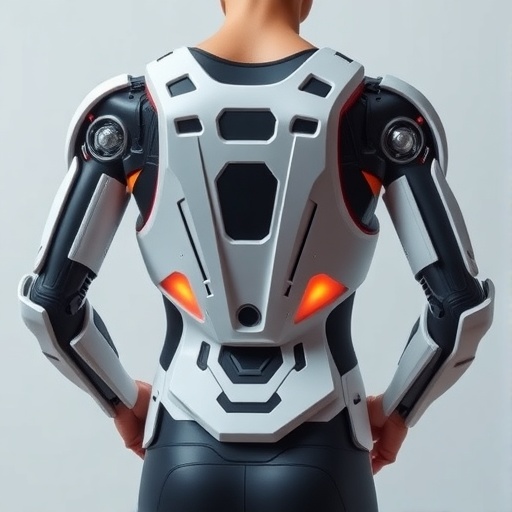In today’s fast-paced world, sedentary behavior has become an increasingly prevalent health concern, contributing to a rising incidence of musculoskeletal disorders globally. Recognizing the critical role of posture in mitigating these conditions, researchers are turning toward innovative technological solutions to promote healthier sitting habits. A recent study published in BioMedical Engineering OnLine introduces an intriguing approach: Samsung Electronics’ wearable robot, called Bot Fit. This device specifically targets lumbar support to enhance proper sitting posture, promising significant benefits for both adults and the elderly.
The human spine’s alignment is crucial in maintaining musculoskeletal health, especially during prolonged periods of sitting—a common lifestyle trait in modern society. Poor sitting posture often results in excessive pressure on spinal discs and surrounding muscles, ultimately leading to discomfort, pain, and chronic conditions such as lower back pain. Bot Fit aims to counter these effects by facilitating a slight anterior pelvic tilt, a subtle but vital adjustment that helps preserve the spine’s natural curvature and reduces long-term musculoskeletal strain.
In the study, 37 participants encompassing healthy adults and elderly individuals were subjected to a series of evaluations designed to quantify Bot Fit’s impact on various biomechanical parameters. Each participant was tested in two states: once while wearing the Bot Fit device and once without it, sitting on a Bobath table to ensure standardized posture conditions. Measurements included muscle tension, spinal angles, sitting height, and the distribution of sitting pressure across the gluteal regions. Such comprehensive data collection provides a robust foundation for analyzing the device’s efficacy.
One of the standout findings was a measurable increase in sitting height when participants wore Bot Fit, indicating a more upright posture. This seemingly simple shift underscores a complex biomechanical improvement: increased rectus abdominis muscle tone suggests enhanced core engagement. Strengthening these muscles can alleviate the load on lumbar structures while promoting spinal stability. The study also reported a significant decrease in upper trapezius muscle tone, which often becomes overstressed during poor posture, contributing to neck and shoulder discomfort.
Pressure distribution analyses revealed compelling insights. The Bot Fit device was shown to increase hip pressure uniformly across all measured regions, which may correspond to improved load-sharing through the pelvis and a reduction in localized pressure points that commonly cause discomfort. Moreover, it significantly decreased the pressure asymmetry between the left and right hips, suggesting that Bot Fit helps balance weight distribution during sitting. This balance is crucial for preventing repetitive strain injuries and maintaining spinal symmetry over time.
From a biomechanical engineering perspective, Bot Fit’s posture correction function utilizes adjustable lumbar support coupled with real-time sensor feedback to modulate muscle activation patterns. The device’s wearable design enables continuous assistance without encumbering natural movement, merging ergonomic principles with cutting-edge robotics technology. Such integration allows for personalized interventions aligned with individual anatomical and functional needs, transcending the “one size fits all” approach common in conventional seating aids.
The implications of this technology reach far beyond immediate comfort. By improving sitting posture and muscle tone, Bot Fit has the potential to serve as a proactive tool in preventing secondary musculoskeletal disorders linked to sedentary lifestyles. These conditions often escalate into costly health issues involving chronic pain and reduced mobility, impacting quality of life and healthcare systems worldwide. The study’s positive results suggest wearable robotics may become a cornerstone in ergonomic health promotion programs.
Further research avenues are ripe for exploration. The current study highlights the importance of customizing Bot Fit’s torque settings—essentially the mechanical force applied by the device—based on variables such as individual weight and gender. Tailoring these parameters could maximize effectiveness and user comfort, facilitating broader adoption among diverse populations. Long-term studies examining sustained use effects and integration with other rehabilitation protocols would further validate Bot Fit’s role in musculoskeletal health management.
What makes the Bot Fit especially innovative is its dual focus on both muscular and biomechanical correction. Unlike traditional lumbar support cushions or braces that passively maintain posture, Bot Fit actively engages users’ core musculature through subtle mechanical cues. This active involvement encourages muscle strengthening, leading to more durable and natural postural improvements. Such design philosophy embodies the future of wearable health technology, where devices support human physiology without substituting for natural function.
Moreover, this research underscores a significant shift in wearable robotics—they are no longer confined to assistance in mobility impairments but are now venturing into preventive health domains. By addressing common yet often overlooked issues like posture-related strain, these devices exemplify how engineering advancements can contribute to public health on a mass scale. The Bot Fit, therefore, represents a pioneering step toward integrating robotics seamlessly into daily health routines.
For professionals in biomedical engineering and ergonomics, the Bot Fit study provides valuable data and a promising blueprint for device development. Understanding nuanced muscle activation patterns alongside mechanical support strategies deepens insights into how wearable robotics can optimize human biomechanics. Cross-disciplinary collaboration between engineers, healthcare providers, and ergonomists will be essential to refine such technologies and to translate laboratory success into real-world health benefits.
In conclusion, Samsung Electronics’ Bot Fit wearable robot stands at the forefront of a novel health intervention paradigm. By promoting lumbar support and enhancing sitting posture through sophisticated mechanical and muscular engagement, it offers a tangible solution to a pervasive health issue exacerbated by modern sedentary lifestyles. As this technology matures and becomes more widely accessible, it holds the potential to transform how populations manage musculoskeletal health proactively, reducing pain, preventing disorders, and ultimately improving well-being globally.
Subject of Research:
Lumbar support and posture correction effects of Samsung’s wearable robot, Bot Fit, on sitting position.
Article Title:
Effects of the lumbar support function of wearable robot (Bot Fit) on sitting position
Article References:
Shin, Jh., Lim, H., Byeon, N. et al. Effects of the lumbar support function of wearable robot (Bot Fit) on sitting position. BioMed Eng OnLine 24, 70 (2025). https://doi.org/10.1186/s12938-025-01402-8
Image Credits: AI Generated




